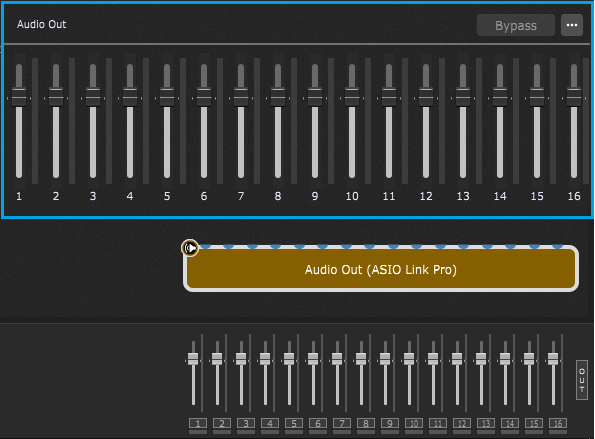The Audio Out plugin represents the current connected physical interface used to send audio or a virtual device, aggregating two or more physical interfaces:

Each plugin port represents one audio output. The actual number of these ports is a function of the capabilities of the interface connected to your system. For example, in the screenshot above, 16 ports are shown.
Double-clicking on the Audio Out plugin opens its editor window, as indicated with the blue rectangle. You can adjust output levels by moving the corresponding sliders. The number of sliders matches the number of output ports. Moving any of these sliders will automatically update the corresponding slider in the bottom toolbar, and vice-versa.
Note: when you create a new gig, this plugin is present by default in the Wiring view and cannot be removed from the design surface. However, you can specify different audio interfaces for Audio Out. Navigate to Options -> Audio Setup to configure your audio interfaces.
Audio Out parameters
The following parameters are available for the Audio Out plugin:
•Number of channels - allows you to get the current number of audio output channels.
•Output Volume (Channel #) - allows you to control the output volume for each output channel available.
•Output Level (Channel #) - allows you to display the output level for each output channel available (use with meter widgets).
•Overall Output Level - allows you to display the overall output level for all channels (use with meter widgets).
•Channel # Muting - mutes the specific channel (# represents the number of the channel).
Note: not all parameters are suitable for the widget control. Parameters such as Number of channels are suited for GPScript or OSC applications. Using scripting it can be determined how many channels the Audio Out plugin offers and then the result can be used for other functions. Using OSC, you can e.g. create the exact number of VU-meters dynamically (if your OSC application supports this feature).